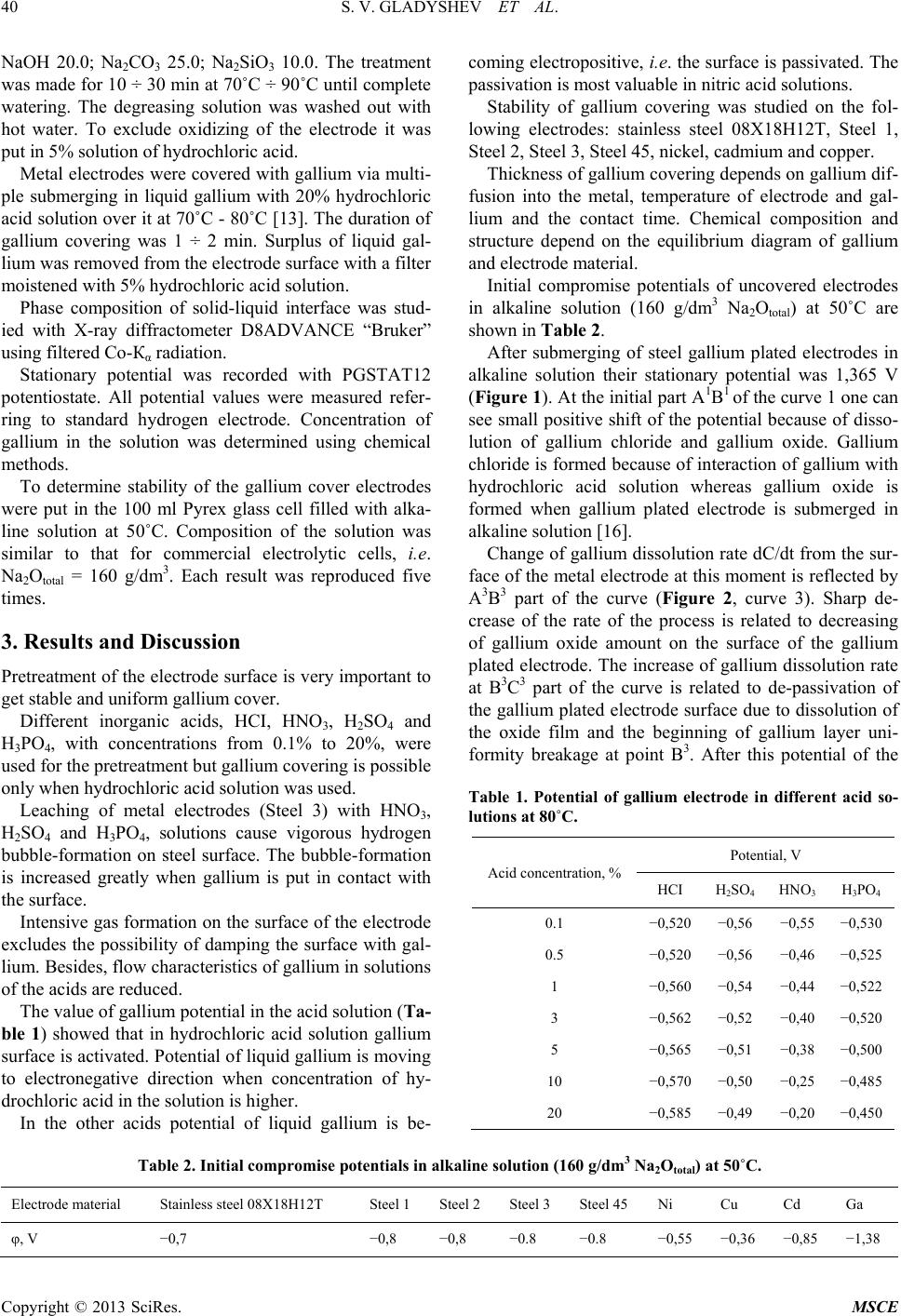
S. V. GLADYSHEV ET AL.
Copyright © 2013 SciRes. MSCE
NaOH 20.0; Na2CO3 25.0; Na2SiO3 10.0. The treatment
was made for 10 ÷ 30 min at 70˚C ÷ 90˚C until complete
watering. The degreasing solution was washed out with
hot water. To exclude oxidizing of the electrode it was
put in 5% sol ution of hy drochl oric acid.
Metal electrodes were cover ed with gallium via multi-
ple submerging in liquid gallium with 20% hydrochloric
acid solution over it at 70˚C - 80˚C [13]. The duration of
gallium covering was 1 ÷ 2 min. Surplus of liquid gal-
lium was removed from the electrode surface with a filter
moistened with 5% hydrochloric acid solution.
Phase composition of solid-liquid interface was stud-
ied with X-ray diffractometer D8ADVANCE “Bruker”
using filtered Со-Кα radiation.
Stationary potential was recorded with PGSTAT12
potentiostate. All potential values were measured refer-
ring to standard hydrogen electrode. Concentration of
gallium in the solution was determined using chemical
methods.
To determine stability of the gallium cover electrodes
were put in the 100 ml Pyrex glass cell filled with alka-
line solution at 50˚C. Composition of the solution was
similar to that for commercial electrolytic cells, i.e.
Na2Ototal = 160 g/dm3. Each result was reproduced five
times.
3. Results and Discussion
Pretreatment of the electrode surface is very important to
get stable and uniform gallium cover.
Different inorganic acids, HCI, HNO3, H2SO4 and
H3PO4, with concentrations from 0.1% to 20%, were
used for the pretreatment but gallium covering is possible
only when hydrochl oric acid soluti o n wa s u s e d.
Leaching of metal electrodes (Steel 3) with HNO3,
H2SO4 and H3PO4, solutions cause vigorous hydrogen
bubble-formation on steel surface. The bubble-formation
is increased greatly when gallium is put in contact with
the surface.
Intensive gas formation on the surface of the electrode
excludes the possibility of damping the surface with gal-
lium. Besides, flow characteristics of gallium in solutions
of the acids are reduced.
The value of gallium potential in the acid solution (Ta-
ble 1) showed that in hydrochloric acid solution gallium
surface is activated. Potential of liqu id gallium is moving
to electronegative direction when concentration of hy-
drochloric acid in the solution is higher.
In the other acids potential of liquid gallium is be-
coming electropositive, i.e . the surface is passivated. The
passivation is most valuable in nitric acid solutions.
Stability of gallium covering was studied on the fol-
lowing electrodes: stainless steel 08Х18Н12Т, Steel 1,
Steel 2, Steel 3, Steel 45, nickel, cadmium and copper.
Thickness of gallium covering depends on gallium dif-
fusion into the metal, temperature of electrode and gal-
lium and the contact time. Chemical composition and
structure depend on the equilibrium diagram of gallium
and electrode material.
Initial compromise potentials of uncovered electrodes
in alkaline solution (160 g/dm3 Na2Ototal) at 50˚C are
shown in Table 2.
After submerging of steel gallium plated electrodes in
alkaline solution their stationary potential was 1,365 V
(Figu re 1). At the initial part А1В1 of the curve 1 one can
see small positive shift of the potential because of disso-
lution of gallium chloride and gallium oxide. Gallium
chloride is formed because of interaction of gallium with
hydrochloric acid solution whereas gallium oxide is
formed when gallium plated electrode is submerged in
alkaline solution [16].
Change of gallium diss olution rate dC/dt from the sur-
face of the metal electrode at this moment is reflected by
А3В3 part of the curve (Figure 2, curve 3). Sharp de-
crease of the rate of the process is related to decreasing
of gallium oxide amount on the surface of the gallium
plated electrode. The increase of gallium dissolution rate
at В3С3 part of the curve is related to de-passivation of
the gallium plated electrode surface due to disso lution of
the oxide film and the beginning of gallium layer uni-
formity breakage at point В3. After this potential of the
Table 1. Potential of gallium electrode in different acid so-
lutions at 80˚C.
Acid concentration, % Potential, V
HCI H2SO4 HNO3 H3PO4
0.1 −0,520 −0,56 −0,55 −0,530
0.5 −0,520 −0,56 −0,46 −0,525
1 −0,560 −0,54 −0,44 −0,522
3 −0,562 −0,52 −0,40 −0,520
5 −0,565 −0,51 −0,38 −0,500
10 −0,570 −0,50 −0,25 −0,485
20 −0,585 −0,49 −0,20 −0,450
Table 2. Initial compromise potentials in alkaline solution (160 g/dm3 Na2Ototal) at 50˚C.
Electrode material Stainless steel 08Х18Н12Т Steel 1 Steel 2 Steel 3 Steel 45 Ni Cu Cd Ga
φ, V −0,7 −0,8 −0,8 −0.8 −0.8 −0,55 −0,36 −0,85 −1,38